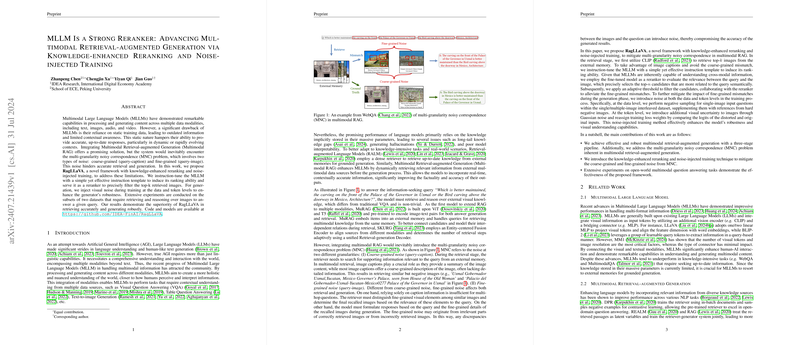Analysis of "MLLM Is a Strong Reranker: Advancing Multimodal Retrieval-augmented Generation via Knowledge-enhanced Reranking and Noise-injected Training"
The paper "MLLM Is a Strong Reranker: Advancing Multimodal Retrieval-augmented Generation via Knowledge-enhanced Reranking and Noise-injected Training" presents significant advancements in the field of Multimodal Retrieval-augmented Generation (Multimodal RAG) within the domain of Multimodal LLMs (MLLMs). The primary contribution is the RagVL framework which addresses the inherent limitations of current MLLM approaches, particularly the multi-granularity noisy correspondence (MNC) problem.
Key Contributions
- Innovative Framework for Multimodal RAG:
- RagVL, the proposed framework, integrates knowledge-enhanced reranking and noise-injected training to handle the MNC problem effectively. The framework enhances the existing multimodal RAG by employing a reranker that instruction-tunes an MLLM, leveraging its cross-modal understanding capabilities to improve retrieval accuracy and generate more relevant content.
- Addressing MNC:
- The paper identifies two types of noise: coarse-grained (query-caption) and fine-grained (query-image). RagVL mitigates these through a two-pronged strategy, leveraging the reranked top candidates and adaptive filtering to ensure more precise matches during the retrieval process, while injecting noise at both data and token levels during training to increase model robustness.
- Robust Experimental Validation:
- The authors conduct extensive experiments using datasets such as WebQA and MultimodalQA. They demonstrate significant improvements in relevant recall metrics, notably achieving high levels of Recall at multiple top-k thresholds across these datasets, reflecting the efficacy of the RagVL method in improving multimodal RAG processes.
Numerical Results and Observations
- The effectiveness of the framework is evident from the R@1, R@5, and R@10 results in retrieval tasks. By inducing ranking ability in MLLMs via instruction tuning, RagVL consistently exhibited superior precision and accuracy compared to traditional retrieval approaches, such as relying solely on CLIP.
- It is noteworthy that the framework achieved a perfect match between performance and oracle settings in several scenarios (e.g., R@20 on MultimodalQA), affirming the strong contribution of their reranking methodology in filtering relevant visual data.
Theoretical and Practical Implications
- Theoretical: The paper suggests a conceptual extension to how MLLMs can be integrated with retrieval systems, offering a pathway to augment static models with dynamic, multimodal data effectively. This approach not only extends the lifecycle of learned models by continuously updating their contextual awareness but also highlights the potential to bridge large gaps between current models and the aspirations for AGI.
- Practical: Practically, this research offers immediate applications in real-time multimodal information retrieval and interaction systems, improving the factual accuracy and interpretability of generated outputs within dynamic environments. The deployment of RagVL can enhance systems where multimodal data is rapidly evolving, such as multimedia retrieval engines and enhanced virtual assistants.
Future Developments
Speculating on future developments stemming from this paper, further research could explore optimizing the efficiency and scalability of the reranking process, particularly through enhancing the computational speed of the reranker or incorporating more sophisticated filtering techniques. Additionally, applying the framework to other multimodal domains, such as video-text retrieval or interactive AI-driven content creation, presents an exciting avenue for extending the reach and capabilities of RagVL.
In conclusion, the paper presents a substantial advancement in the field of multimodal retrieval-augmented generation, rooted in a rigorous and technically sophisticated framework. The potential applications of this research in various AI-driven sectors underscore its importance, offering pathways for future exploration and refinement in multimodal data processing.
